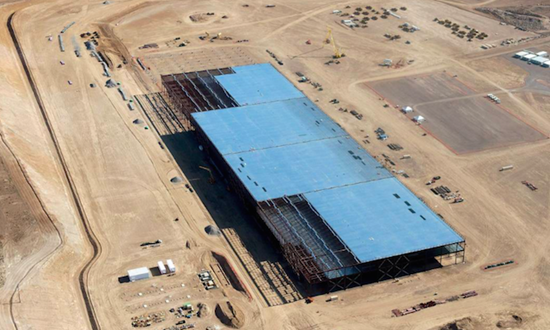
It’s the consensus of the scientific community that not only is global climate change actually happening, but that it is a direct result of human activities; further, that its effects are likely irreversible. A recent U.N. panel warned that without a global effort to reduce emissions and implement clean energy initiatives, we, our children, our children’s children will face some very formidable challenges in the decades to come.
To that end, science is always on the lookout for ways to improve the efficiency and efficacy of clean energy alternatives. Here are some interesting developments which we can expect to hear a lot more about in the near future.
10. Self-Sustaining Villages
California developer ReGen Villages has undertaken a pilot program in the Netherlands, which they hope to subsequently expand to several other European countries including Sweden and Germany. Their concept could eventually revolutionize real estate and suburb development. They would build residential communities centered around farm land, then implement high technology to make these suburbs completely self-sustaining.
In addition to using vertical organic farming techniques to keep residents fed year round, these communities will manage waste and generate clean power on site. In fact, the pilot community is projected to generate a power surplus, which can be redistributed to surrounding grids. A Danish architectural firm is handling the design, which will include 25 residences upon completion in 2017. This will eventually expand to 100.
ReGen hopes to use the success of this pilot village to move into Northern Europe next, where cold climates translate to a larger demand for power; population-dense areas of India and Africa would be next on the agenda.
9. Waste Powered Fuel Cells
While others have spearheaded this area of study, researchers at the University of Bath have perfected a tiny, one-inch squared “microbial fuel cell” capable of extracting electricity from bacteria in urine. As odd as this might sound, the technology is a home run in overcoming the so-called “energy trilemma.” That’s the need for alternative fuel sources to be at once secure, affordable, and sensitive to the environment.
The amount of energy we’re talking about here is not trivial. Just one of the tiny fuel cells can generate enough to power a small electronic device, and the amount of power is increased proportionally when devices are stacked together. While the power output falls short of that achieved by other clean energy sources such as solar, this tech has the significant benefit of being extremely cheap to produce. Each unit costs no more than a couple dollars, and produces practically no waste of its own.
Of course, it also runs on a fuel source that will never be scarce, and the team hopes that their research will help bring power to highly impoverished areas and places where conventional power delivery is impractical. Or, as stated by Dr. Tim Mays, head of the Chemical Engineering Department at Bath, “Renewable ‘pee-power’ is a brilliant idea and its use in developing countries will have huge positive impact on people’s lives in areas of energy poverty.”
8. Lithium Ion Battery/Solar Panel Grids
However you feel about Tesla and Elon Musk, it’s tough to argue that not many other extremely rich people seem to be trying to make a difference, environmentally speaking. While Tesla’s famed electric vehicles have a modest but rabid fan base, Musk himself thinks that Tesla’s other major project - the one engineers have been busily working on at their Nevada “Gigawatt” factory - will eventually generate much more revenue for the company, and be much more important in terms of environmental responsibility.
Tesla’s Lithium Ion battery packs, initially marketed as supplemental energy storage for their vehicles, could go a long way toward reducing the electricity load on the average household, which is where Musk thinks consumers will eventually get the most use out of it. On the low end, the Gigawatt factory is expected to produce 35 Gigawatt Hours worth of these batteries per year - a figure representing, well, just an insane amount of energy - and has the capacity to triple this production, should demand warrant it.
With their Powerwall whole-house battery underwhelming in its pre-order sales, the company has shifted focus to grid-companion applications such as the battery packs. Interestingly, in Hawaii - where utility prices are consistently through the roof - solar power company Solar City, which is chaired by Musk, is constructing a new plant using a giant bank of Tesla batteries to keep the grid flowing during high-demand periods. This could be seen as a type of proof of concept for further battery/solar grid designs in the future. At the time of this writing, Tesla is attempting to merge with Solar City, a move that has been met with mixed reviews.
7. Solar Panel Maintenance Drones
Speaking of solar power, the original alternative energy source has demonstrated remarkable staying power since it was first made commercially available in 1956. While easily the most efficient of all clean energy sources in terms of output, it takes enormous solar panel farms comprising hundreds of acres in order to power a significant population. As one can imagine, these vast panel arrays are very difficult and expensive to inspect, maintain, and manage. Yet failing to maintain the panels properly leads to reduced efficiency. On top of this, many such farms are located in remote, dangerous areas (like the middle of the Arizona desert), making maintenance a genuine safety hazard.
Enter the friendly drone. One California solar company, CalCom Solar, is already using them to map out its finished projects, and is envisioning using existing technology to basically turn drones into automated solar panel maintenance machines. Broken panels give off a distinct heat signature, one easily detectable by a drone with a thermal imagine camera. The same panel might take weeks to detect by workers with handheld devices, who notably cannot fly.
Even maintenance can be made easier with UAVs. German engineer Ridha Azaiz, who began kicking his idea around as a 13-year old, has created specialized brushes that can be attached to drones, which then gently clean dust and dirt from the surface of the panels. This helps them operate up to 35% more efficiently.
6. Artificial Photosynthesis
In two separate studies published just weeks apart, Swiss and American scientists have moved several steps closer to artificially reproducing the chemical process that takes place in natural photosynthesis. And therefore, we’re one step closer to actually being able to convert sunlight into a chemical fuel.
Using artificial molecules created for the experiment, the Swiss researchers at the University of Basel, Zurich, were able to produce storable charges by exciting the molecules with a laser. Importantly, this was achieved without using sacrificial molecules as “electron donors,” a barrier which had previously made the process prohibitively inefficient.
The American team, meanwhile, employed a catalyst: barium titanate molecules, which are ferroelectric (able to create internal electric fields). Light striking the barium titanate molecules results in something called “charge separation,” which (long story short) helps facilitate the splitting of water into oxygen and hydrogen. All of this is to say that different groups of brilliant people are very close to creating cheap fuel from light and water, in the hope that one day we will be able to satisfy our energy needs by emulating trees, rather than cutting down untold acres of them.
5. Nanotech Solar Windows
Likewise, many enterprising scientists are working on slightly different approaches to turning ordinary windows into solar power generators. This is being accomplished by integrating everyone’s favorite potential world-ender, nanotechnology, with photovoltaic cells.
Scientists at the appropriately named Nano-Science Center in Lausanne, Switzerland, have spent years perfecting “nanowire crystals” - tiny little tubes, of which it would take 10,000 to equal the thickness of a human hair. The idea is that these nanowires, which are conductive, cause a resonance in the light passing around them. This makes them smaller than the light’s wavelength, which results in concentrations of the intensity of the light by a factor of 15. That’s significantly higher than traditional solar panels. Of course, the nanowire array is tiny enough to be invisible when applied to glass. Conceivably, this could turn every window in your house into a little power generator.
Though the technology has been around for a few years, the Swiss team’s efforts yielded far more power output than had yet been accomplished or, indeed, was even expected. This bodes well for a relatively speedy commercial debut, assuming the average consumer won’t automatically be terrified of anything with the “nano” prefix attached to it, no matter how benign.
4. Quantum Smart Grids
Among the many helpful applications we can expect from the forthcoming first generation of quantum computers, we…okay, let’s face it. They haven’t exactly told us much about what to expect from them, other than that they can perform calculations billions of times faster than conventional computers. And also, a quantum processor won’t exactly work with your laptop. We do know that rather than the “bits” used by traditional processing (which are like switches, set to either 1 or 0), quantum processing uses “qubits” - which, in addition to the 1 and 0 settings, can be set to an “indeterminate” quantum state. This allows for many things, like the aforementioned lightning-fast processing, and unbeatable cryptography.
Now, consider an electric grid. Many large grids draw from a variety of resources, including both conventional power and renewables. How much is drawn, and from where, is determined by supply, demand, and usage. Enormous amounts of data transmission is involved in monitoring said usage, determining the most efficient means of delivery, keeping track of resources, and a million other things to ensure that a minimal amount of power is wasted and supply is kept constant.
In 2009, the U.S. allocated billions in funding for “Smart Grids” in every state but Alaska. These maximize this process using modern communication technology to create a “renewables superhighway.” A Los Alamos National Laboratory research team has proposed a solution to the significant issue of data security in implementing these Smart Grids - a “network-centric quantum communication” card, which will “(meet) the challenging simultaneous latency and security requirements of electric grid control communications, which cannot be met without compromises using conventional cryptography.”
While this is but one potential use for quantum cryptography, it could be an important one. Large scale adoption would dump money into further research and development of the next generation of quantum devices.
3. Hydrogen Producing Algae
In another example of a budding technology that could be employed for a cheap, personal fuel cell (which does not involve pee), the National Renewable Energy Laboratory is attempting to devise a process for enhanced photosynthesis. Not artificial, but of the natural kind, using microscopic algae.
Chlamydomonas reinhardtii is a friendly little algae that could technically be considered more plant than animal. Though it shares several genes that are associated with human functions, it is photosynthetic. Like other such organisms, it produces hydrogen, and researchers have taken the first step towards a means to get it to produce more. Quite a bit more. In a nutshell, they have narrowed down the pathways through which it is believed electrons pass through the algae from six to two. The idea will be to block the less productive pathways and promote it in the desired ones, leading to increased hydrogen production.
If this doesn’t sound like such a big deal, consider that hydrogen takes much more conventional energy to produce than the net energy gained from its production. A sustainable hydrogen source, like naturally reproducing super-algae, would be a holy grail of sorts. And, could lead to small desktop bio-reactors that could easily power whatever you’re reading this on.
2. Nuclear Molten-Salt Reactors
Despite being a fantastic source of cheap power, nuclear energy has gotten a bad rap mainly due to two words, those words being “Chernobyl” and “Fukushima.” While the potential disastrous downside of proliferating nuclear power plants led to a steep decline in usage over the last several decades, the next generation of nuclear reactor aims to eliminate concerns of a meltdown altogether.
While the technology was conceived of in the 1960s, molten-salt reactors - which are powered by liquid fuel, rather than the conventional fuel rods - are making a comeback thanks to the efforts of a four-year project by a European consortium of research institutes dubbed “Samofar” (Safety Assessment of the Molten Salt Fast Reactor). In assessing the safety of the technology compared to standard nuclear reactors, a laundry list of advantages were named in pressing for a prototype to be built by 2020.
Chief among these is that molten-salt reactors are ideally suited to run on thorium, which is much more abundant than uranium. The liquid fuel, a radioactive solution combined with liquid salt, expands when heated and thus regulates itself. A fail-safe causes any excess to automatically drain to a shielded container far underground.
Though the process for approval of new nuclear reactor designs remains daunting, especially in the United States, Samofar hopes to get it underway soon. The Shanghai Institute of Applied Physics is already working on a prototype of their own version in conjunction with Oak Ridge National Laboratory, the granddaddy of all nuclear research facilities.
1. Space Based Solar Power
Finally, in an effort to bring the original alternative energy source roaring into the new century, the Japan Aerospace Exploration Agency achieved a giant step forward for the possibility of satellite-based solar farms when they successfully transmitted 1.8 kilowatts of electric power to a pinpoint location using microwaves. Although the idea of putting solar panels in space has been around for decades, and was deemed technologically (if not economically) feasible in the 1970s, reliable transmission of the power collected - obviously the most important part of the process - had always been viewed with skepticism.
Although the technology may not come into practical use for some time, its potential is undeniably exciting. Satellite-based farms in geosynchronous orbit can farm sunlight constantly, unaffected by weather conditions. JAXA suggests that a single Earth-based receiver could generate up to one gigawatt of power, the same as the average nuclear reactor.
Perhaps more so than any other entry on this list, satellite-based solar arrays truly have the potential to provide more clean energy than we could ever possibly use, considering that more solar energy reaches the surface of the planet in a single day than it could consume in an entire year.










No comments:
Post a Comment
Please adhere to proper blog etiquette when posting your comments. This blog owner will exercise his absolution discretion in allowing or rejecting any comments that are deemed seditious, defamatory, libelous, racist, vulgar, insulting, and other remarks that exhibit similar characteristics. If you insist on using anonymous comments, please write your name or other IDs at the end of your message.